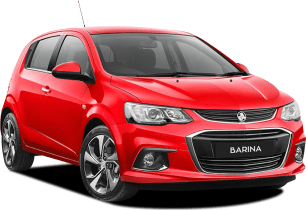The Barina has one of the larger interiors of the segment, thanks in large part to its high roofline. It measures a close-to-its-peers 4039mm long and 1735mm wide, but at 1517mm tall, it isn’t far off compact SUVs.
There is really good headroom front and rear, and the driver’s seat has height adjustment - meaning taller drivers can lower themselves in pretty nicely, but the passenger front seat doesn’t have height adjust, and it sits quite high.
The media system is a 7.0-inch touchscreen with two USB ports (one to connect, one to charge - both located in the top glovebox) and Bluetooth phone and audio streaming - and you get that system in both variants. The screen is supposed to have Apple CarPlay and Android Auto, but when I connected my iPhone it wouldn’t show up the mirroring screen… which was annoying, because there’s no sat nav.
The driver-info display may be a monochrome thing, but it is super handy to have a digital speed readout, and you can keep an eye on other key bits of info, like fuel use.
Back-seat legroom is adequate, but not exceptional - behind my own driving position (I’m 183cm tall) my knees were hard-up against the seat. You could fit two adults in the back pretty comfortably, but three would be hard work. If you tend to transport younger passengers, the dual ISOFIX and three top-tether child-seat anchors will come in handy.
Storage in the back is poor - there is no rear door storage at all, only one map pocket and no fold-down armrest. There’s just a single cup holder in front of the middle seat.
Up front there are two cupholders between the seats, and there are large pockets in the doors but they aren’t formed to hold bottles, so your fizzy might go flat from shifting around. The dashboard console is quite small, and there’s no covered armrest between the seats - but the driver gets a van-style armrest.
The biggest issue I have with the cabin is that the steering wheel is huge - like, it’s the same one used in the old Commodore, and it’s way too large for the Barina’s cabin - and the gear-shifter is oversized, too. Smaller features would make for a more spacious cockpit, and it’s a bit too easy to accidentally put it all the way down into M for manual mode, rather than D.
The boot of the Barina is fairly good for its size at 290 litres (VDA), and that expands to 653L with the back seats folded down in 60/40 formation - it’s a good cargo hold, albeit with a large, deep load lip, and there’s a space-saver spare under the floor.
There are some other little things that are good: the fact the electric windows have auto-down (and auto-up on the fronts). And some things that aren’t: the masses of hard, cheap-feeling plastics; the knobs and dials that don’t feel great to turn; and the seats are pretty uncomfortable.



































